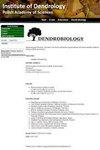松栎混交林中物种多样性模式因生活阶段而异
IF 1.8
4区 农林科学
Q2 FORESTRY
引用次数: 0
摘要
天然林由不同种类和大小的树木组成,构成了一个“生物框架”。尽管经常在不同的空间尺度上对多样性模式进行检查,但很少考虑生命阶段。松栎混交林广泛分布于世界各地,是我国西南南盘江流域的主要林型。我们在一个未受干扰的林分中建立了一个面积为100 m×100 m的固定地块,并根据树木的胸径和高度按五个生命阶段对其进行了分类。然后,我们计算了每个生命阶段的八个传统多样性指数。我们发现物种丰富度(R)、丰富度(N)和三个多样性指数随着生命阶段的增加先增加后减少。随着采样面积的增加,R、Shannon Wiener指数(H’)和Simpson多样性指数(D)首先快速增加,然后增加率降低,而N呈线性增加,三个均匀度指数呈逐渐下降。每个多样性指数的Global Moran’s I值较小,表明空间自相关较弱。灌木和幼树的R和N均随生命期的增加而急剧下降,只有大树构成了生命后期。我们的研究结果表明,松栎林的物种多样性模式,特别是在早期演替阶段,在不同的生命阶段有所不同。这些变化有助于理解和保护森林生物多样性。本文章由计算机程序翻译,如有差异,请以英文原文为准。
Species diversity patterns differ by life stages in a pine-oak mixed forest
Natural forests comprise trees of different species and sizes, constituting a “biotic framework”. Although examinations of diversity patterns at various spatial scales are frequently conducted, life stages are rarely accounted for. Pine-oak mixedwood forest is widely distributed around the world and constitutes main forest type in the Nanpan River Basin in southwest China. We established a fixed plot with an area of 100 m × 100 m in an undisturbed forest stand and classified trees according to five life stages based on their diameter at breast height (DBH) and height. Then, we calculated eight traditional diversity indices for each life stage. We found that species richness (R), abundance (N), and three diversity indices first increased and then decreased with increasing life stage. As sampling area increased, R, the Shannon-Wiener index (H') and Simpson’s diversity index (D) first increased quickly, followed by a reduced rate of increase, whereas N showed a linear increase and three evenness indices showed gradual decreases. Global Moran’s I values for each diversity index were small, indicating weak spatial autocorrelation. Both R and N of shrubs and saplings decreased sharply with life stage, with only large trees comprising the later life stages. Our results indicate that species diversity patterns in pine-oak forests, particularly in early successional stages, differ among life stages. The changes contribute to the understanding and conservation of forest biodiversity.
求助全文
通过发布文献求助,成功后即可免费获取论文全文。
去求助
来源期刊

Dendrobiology
农林科学-林学
CiteScore
2.20
自引率
11.10%
发文量
17
审稿时长
>12 weeks
期刊介绍:
Dendrobiology publishes original research articles and review articles related to the biology of trees and shrubs.
 求助内容:
求助内容: 应助结果提醒方式:
应助结果提醒方式:


